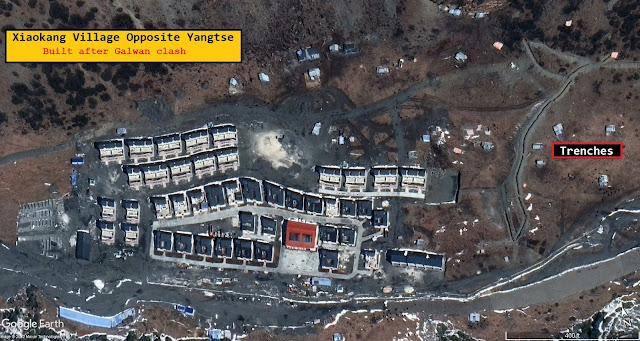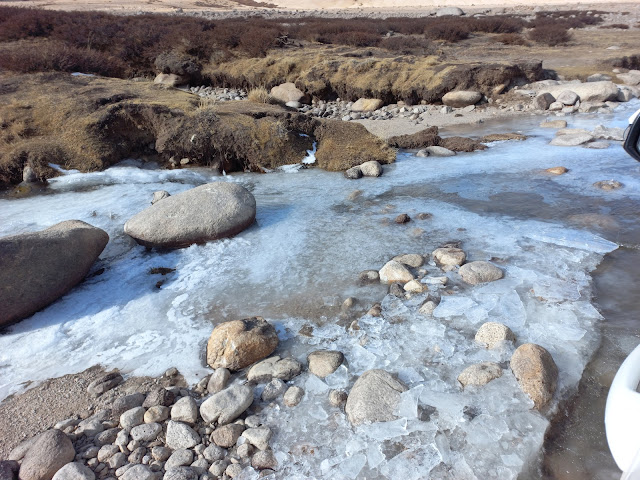 |
| A Very Sacred Place: Arunachal Pradesh CM inaugurating a small gompa in the area |
Here is the link
Unless maps of the different perceptions are exchanged and a Line of Actual Control is agreed upon by both parties, clashes will continue, with the risk of degenerating into a larger armed conflict
It is important to understand how the northern border of India has been delineated. From the end of the 19th century, the main factor for fixing a boundary in the Himalaya, in particular with Tibet, India’s northern neighbour, has been the watershed principle.
During the Simla Conference in 1913-14, Sir Henry McMahon, India’s foreign Secretary and Lonchen Shatra, the Tibetan Prime Minister representing the 13th Dalai Lama, agreed to define the border between their nations; they signed, with seals, a map, today known as the ‘McMahon Line’, though ideally it should be the ‘McMahon-Shatra Line’.
It should be noted that Ivan Chen, the Chinese Plenipotentiary, who was present during the Conference, did not object to the presence of Lonchen Shatra on the same footing as him and India’s Foreign Secretary, and this for months.
Till 1954, when India unnecessarily agreed to the ‘Five Principles of Peaceful Co-Existence’ (Panchsheel), the Line was a peaceful frontier with Tibet; but the ink had not dried on the agreement that it became a ‘disputed’ border with China, with serious consequences for India, which continue to be seen today.
Apart from the watershed, other principles can be used to define a frontier, i.e. rivers running in the area, land tax patterns or grazing rights of the local population; this has been done in some cases.
It is a fact that during the previous centuries, no dispute had taken place with Tibet in the remote Himalayan areas; with the arrival of the People’s Liberation Army (PLA) on the border at the end of the 1950s, all this changed.
 |
| A very old dispute indeed (Chinese map of 1960) |
While the first clash with the PLA took place in the Central Sector (Barahoti) in 1954, by mid-1959, soon after the Dalai Lama crossed to India, the Chinese started intruding in the Eastern Sector. Three places soon became ‘disputed’ (today one can count seven); these were Khenzimane, Yangtse and Longju.
It is Maj Bob Khathing, who after touring the area, demarcated the border in the Yangtse sector at the end of 1951. It was later confirmed by a detailed survey in 1954, as well as during tours of Indian officials in the following years; in Yangtse, the border was along the Kanglung Himalayan ridge.
In some cases, the border had to be slightly adjusted with the McMahon Line which, at time was imprecise due to the fast pace McMahon’s surveyors had to work before the Simla Conference and the inadequate equipment available at that time.
No fixed LAC
While China still today claims the entire Arunachal as theirs, the Line of Actual Control (LAC) remains officially undefined.
Maps of the Chinese and Indian perceptions of the LAC were exchanged in 2000 for the Central Sector (Barahoti); maps of the Northern Sector (Ladakh) came on the table for 20 minutes during a joint meeting in 2002, but were later withdrawn as China did not agree to Delhi including Gilgit-Baltistan in India’s territory.
In the case of the Eastern Sector (particularly of Tawang), maps have never been exchanged or even seen. This compounds the present confusion (often to the advantage of Beijing) and reinforces Chinese perceptions.
Sixty-two years later, the 1960 ‘disputed’ places remain ‘hotspots’ and it was expected that a flare-up could take place on any one of this places (one could also add Asaphila in the Upper Subansiri district as a possible point for a future clash).
The last flare-up took place on 9 December in Yangtse.
Indian troops were ready to retaliate
An unofficial report explains that the area under attack has “a commanding view of the ridges and tracks across the LAC deep into Tsona County in Tibet. The PLA were roughly 300 troops.”
It is far more than for their ‘routine’ intrusions.
They used melee weapons with a clear intention to harm the Indian troops holding the area: “Closely placed echelons on the lower ridges and the river valley were quickly able to reinforce the 50 troops firmly facing the PLA onslaught and reinforcements poured in from multiple directions immediately after being radioed.”
The report continues: “What started with abuses and stone pelting gradually progressed to fisticuffs and then fierce hand to hand combat where the PLA troops were overpowered and in some cases their weapons were used against them. This free for all went on until the PLA found itself losing ground with many of their troops overpowered and battered.”
The Chinese troops then started falling back on their side of the LAC.
Interestingly, they left behind some sleeping bags and other equipment which indicates that they had come to stay.
Medieval Weapons
Like in Galwan on 15 June, 2020 (it was Xi Jinping’s birthday), the PLA used melee weapons and shields. This time, the Indian soldiers were ready with the same equipment.
The reason why guns were not used is the “Agreement on the Maintenance of Peace and Tranquility along the LAC” signed by China and India in September 1993, agreeing to maintain the status quo on their mutual border pending a final solution, as well as the 1996 Agreement on Confidence-Building Measures in the Military Field” on the LAC, which mentioned: “No armed forces deployed by either side in the border areas along the line of actual control as part of their respective military strength shall be used to attack the other side, or engage in military activities that threaten the other side or undermine peace, tranquility and stability in the India-China border areas.”
Can this be considered a positive aspect during in these tense moments?
 |
| The gompa at Chumig Gyatse close to the LAC in the same sector |
Development of Chumi Yangtse area
Though the Opposition would like to blame the Government for the incident, tremendous efforts have been made by Delhi in the recent years to develop the border areas in this sector and elsewhere.
It is enough to mention the opening of a new gompa (monastery); dedicated to Guru Padmasambhava, who meditated there in the 8th century, it is located a few hundred meters south of the LAC.
The Chief Minister of Arunachal Pradesh, Mr Pema Khandu himself walked to this exceptionally sacred place, blessed by 108 waterfalls, to inaugurate the gompa in July 2020.
It has to be noticed that the Chinese did not object to the construction of the gompa and its opening to Indian tourists in July 2020.
 |
| Xiaokang village north of the LAC (@NatureDesai) |
A rather disturbing news that is China may have used one of the Xiaogang border villages (Beijing has built more than 600 of them, officially, ‘moderately well-off’ villages for the welfare of the local populations) as a base for their operation.
Does it mean that this string of villages on the border can just be used as garrisons for the PLA to launch attack on India?
This issue has to be followed closely by the Indian government (Army and Security agencies).
Xi Jinping abroad
President Xi Jinping was out of China (in Saudi Arabia) when the incident took place. Was he informed about the massive attack on the Indian position? Like when more than one thousand PLA troops intruded in Chumar (Ladakh) in September 2014, while Xi was visiting India?
Informed or not, such an operation needs a high level of clearance, at least from the Central Military Commission in Beijing.
End of the COVID lockdown
The Tibet Region, including the Tibetan Military District, which is responsible for the border, has been under severe (not to say brutal) COVID restrictions since the month of August; it is clear the PLA could not move earlier.
The lockdown had just been lifted when the incident in Yangtse took place and with the winter coming, rendering the logistics more complicated, Beijing had not much choice of options to show India that it has not forgotten the old disputes.
A longer stand-off would have undoubtedly been difficult for the PLA. At the same time, the CMC was probably not expecting such a stiff Indian resistance; it was therefore better for the PLA to withdraw as if nothing ‘big’ had happened.
China will not drop the ‘disputed’ area
In a press statement, Senior Colonel Long Shaohua, the spokesperson for the Western Theater Command in Chengdu claimed that it was the Indian troops who illegally crossed the LAC; he said: “The Chinese troops made a professional, normative and resolute response, bringing the on-site situation under control. Up to now, the Chinese and Indian troops have disengaged,” said the Chinese military officer.
Interestingly, he did not mention that a number of Chinese soldiers were severely injured.
The above means that the intrusions will continue, whether in Yangtse, Sumdorong chu or Asaphila (or in the Fish Tails area in Eastern Arunachal).
The status quo
India’s Defence Minister made a statement in the Parliament; he said: “On 9 December 2022, PLA (People’s Liberation Army of China) troops tried to transgress the LAC in Yangtse area of Tawang Sector and unilaterally change the status quo. The Chinese attempt was contested by our troops in a firm and resolute manner.”
Status Quo is the need of the hour, until a LAC (if not a IB) is agreed upon, the status quo should be respected by both parties.
Need to demarcate the LAC
One way forward could be to hold Ladakh-type talks for the Eastern Sector.
After 16 rounds of talks in Moldo/Chushul, some progress has been made to delineate a LAC, though in two areas (Demchok and Depsang), China has refused to vacate the areas occupied in May 2020.
Unless maps of the different perceptions are exchanged and a LAC is agreed upon by both parties, clashes will continue, with the risk of degenerating into a larger armed conflict.

















.JPG)













